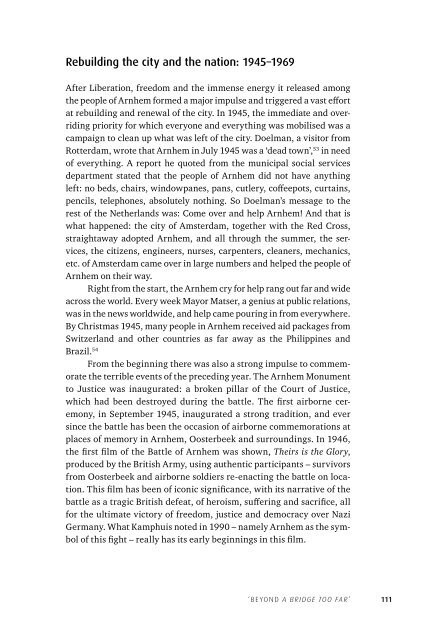Discord Consensus
7aze300jFJo
7aze300jFJo
Create successful ePaper yourself
Turn your PDF publications into a flip-book with our unique Google optimized e-Paper software.
Rebuilding the city and the nation: 1945–1969<br />
After Liberation, freedom and the immense energy it released among<br />
the people of Arnhem formed a major impulse and triggered a vast effort<br />
at rebuilding and renewal of the city. In 1945, the immediate and overriding<br />
priority for which everyone and everything was mobilised was a<br />
campaign to clean up what was left of the city. Doelman, a visitor from<br />
Rotterdam, wrote that Arnhem in July 1945 was a ‘dead town’, 53 in need<br />
of everything. A report he quoted from the municipal social services<br />
department stated that the people of Arnhem did not have anything<br />
left: no beds, chairs, windowpanes, pans, cutlery, coffeepots, curtains,<br />
pencils, telephones, absolutely nothing. So Doelman’s message to the<br />
rest of the Netherlands was: Come over and help Arnhem! And that is<br />
what happened: the city of Amsterdam, together with the Red Cross,<br />
straightaway adopted Arnhem, and all through the summer, the services,<br />
the citizens, engineers, nurses, carpenters, cleaners, mechanics,<br />
etc. of Amsterdam came over in large numbers and helped the people of<br />
Arnhem on their way.<br />
Right from the start, the Arnhem cry for help rang out far and wide<br />
across the world. Every week Mayor Matser, a genius at public relations,<br />
was in the news worldwide, and help came pouring in from everywhere.<br />
By Christmas 1945, many people in Arnhem received aid packages from<br />
Switzerland and other countries as far away as the Philippines and<br />
Brazil. 54<br />
From the beginning there was also a strong impulse to commemorate<br />
the terrible events of the preceding year. The Arnhem Monument<br />
to Justice was inaugurated: a broken pillar of the Court of Justice,<br />
which had been destroyed during the battle. The first airborne ceremony,<br />
in September 1945, inaugurated a strong tradition, and ever<br />
since the battle has been the occasion of airborne commemorations at<br />
places of memory in Arnhem, Oosterbeek and surroundings. In 1946,<br />
the first film of the Battle of Arnhem was shown, Theirs is the Glory,<br />
produced by the British Army, using authentic participants – survivors<br />
from Oosterbeek and airborne soldiers re-enacting the battle on location.<br />
This film has been of iconic significance, with its narrative of the<br />
battle as a tragic British defeat, of heroism, suffering and sacrifice, all<br />
for the ultimate victory of freedom, justice and democracy over Nazi<br />
Germany. What Kamphuis noted in 1990 –namely Arnhem as the symbol<br />
of this fight –really has its early beginnings in this film.<br />
‘BEYOND A BRIDGE TOO FAR’<br />
111


